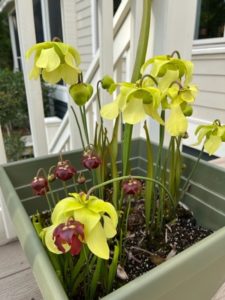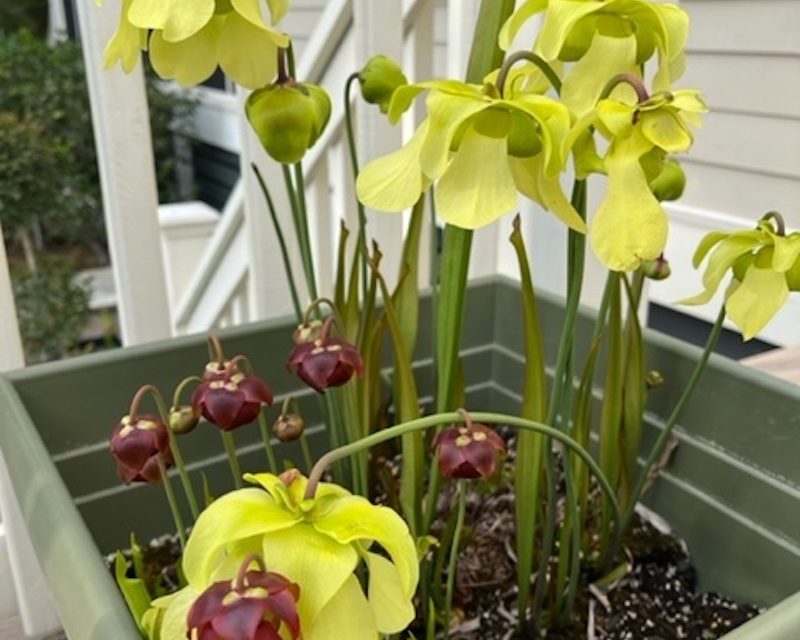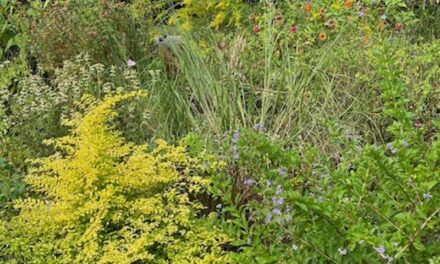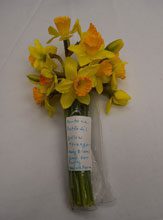
Pitchers in bloom
I have lots of favorite plants in my garden, but the ones that are really dear to my heart are carnivorous. That is right. They do not go after humans like Audrey II in “Little Shop Of Horrors,” but they do like flies and no-see-ums. How can you not love a plant that eats no-see-ums, or “flying teeth” as my husband calls them? These are Pitcher plants or Sarracenia.
Pitcher plants are indigenous to the eastern seaboard of the United States as well as Texas, parts of the Great Lakes region, and southeastern Canada. Instead of leaves, the plant has evolved funnels or pitchers to attract and trap insects. It attracts insects by secretions on the lip of the pitcher. The pitchers may also be brightly colored and scented. Once on the lip of the funnel, it is a slippery slope and insects fall inside where they are digested by the plant. Yum Yum. When I cut my dead pitchers down in the fall and look inside, I see all kinds of insect remains.
These plants also have beautifully unique flowers that appear in the early spring before the new pitchers appear. The flowers are designed to attract bees to pollinate the different plants. They are unlike any flowers that I have ever seen and almost resemble those faux plastic flowers on hummingbird feeders.
Sarracenia are perennial and like distinct seasons. They will die down in the cold, but our hard freeze did not impact them at all. I was worried, but those flowers appeared at the end of March and the pitchers were right on schedule in April.
Pitchers tend to grow in boggy areas with an acidic or low pH soil. They particularly like pine savannas that have been maintained by controlled fires as well as wet prairies and bogs with sphagnum moss. Remarkably, they have been naturalized by plant collectors in various countries such as Switzerland, Ireland, and the Lake District in England. There is a pitcher plant vendor in the giant tent at the Chelsea Flower Show when I have visited and that stand is always crowded with buyers.
They are protected in most states including South Carolina. Native pitchers are threatened by development and drainage of their home territory. Florists have cut pitchers to use in displays and plant hunters gather them to sell. I bought my pitcher plants from a certified grower in the Pacific Northwest who legally propagates and sells various carnivorous plants.
When my pitchers arrived, I followed the instructions and tried to replicate their habitat. I bought a large plastic planter. I used plastic because it holds moisture better than terracotta. I filled the container with a mixture of peat moss and perlite and made certain that there were drainage holes in the bottom. You don’t want to drown the poor things.
I use only distilled or purified water because the chemicals in our local water from the tap will kill these plants. I keep the soil moist at all times. I then planted them and watched them grow. They are incredibly hardy once they get going. They like full sun or at least sun a good part of the day. I have mine on a very hot south facing deck.
Because my husband was agreeable to sharing his grilling space with the plants, I let him name them. My first two plants are Bob Feller and Herb Score. Needless to say my husband is a long time Cleveland Indians (Guardians) fan. I wanted two more pitchers and decided that we needed some diversity. I now have Satchel Paige and Pedro Martinez. They are small, but coming along with some vigor.
There is a wonderful collection of Pitcher plants at the Coastal Discovery Museum at Honey Horn Plantation on Hilton Head. That was where I first saw the plant and fell in love.
Why have just a pot of petunias on your deck or patio when you can have a container of these odd looking but beautiful plants? They are native and they eat things that bite us. This is my kind of plant!









